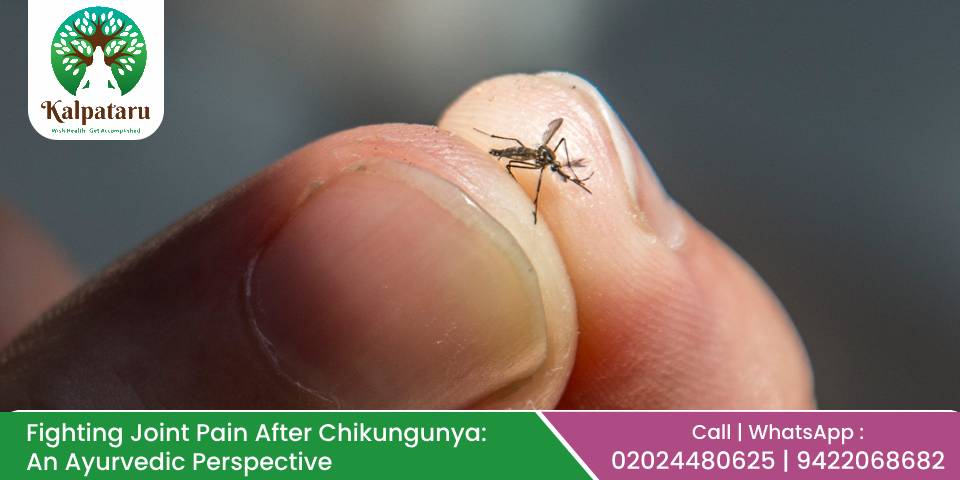Chikungunya is a viral infection spread by mosquito bites, primarily characterized by severe joint pain and fever. While the fever generally subsides in a week or two, joint pain, stiffness, and swelling can linger for months, significantly impacting quality of life. Understanding the nature of post-Chikungunya joint pain and exploring both conventional and Ayurvedic approaches to manage it can bring relief to those affected.
Understanding Post-Chikungunya Joint Pain:
After a Chikungunya infection, some people may experience residual joint pain and stiffness, also known as “post-viral arthritis.” This pain primarily affects the wrists, ankles, fingers, knees, and other large joints, with the severity varying from person to person. The exact cause of persistent pain isn’t entirely understood, but it’s believed that the virus may remain in the body, continuing to trigger inflammation in the joints.
This lingering pain can lead to:
- Stiffness in the affected joints, particularly after periods of rest.
- Fatigue due to ongoing discomfort and limited mobility.
- Swelling and tenderness in the joints.
- Reduced mobility and functional limitations.
Conventional Approaches to Managing Joint Pain:
Treatment for joint pain post-Chikungunya usually focuses on symptom management:
- Pain Relief Medication: Non-steroidal anti-inflammatory drugs (NSAIDs) can help alleviate pain and reduce inflammation.
- Physiotherapy: Gentle exercises and stretching help improve joint mobility and reduce stiffness. Specific low-impact activities like swimming or yoga are also effective.
- Hydration: Drinking sufficient of fluids assists the body in flushing out residual toxins and viruses, which may help reduce inflammation.
While these approaches offer relief, Ayurveda provides a holistic perspective that not only addresses symptoms but also aims to restore balance in the body.
Ayurveda's Perspective on Joint Pain After Chikungunya:
Ayurveda, a traditional system of Indian medicine, views joint pain following Chikungunya as a manifestation of Vata and Kaf dosha imbalance, exacerbated by the body’s weakened state post-infection. Vata dosha governs movement, flexibility, and function of the joints, and when imbalanced, it leads to symptoms such as stiffness, pain, and dryness in the joints. Deranged kaf dosh leads to joint information
Ayurvedic Remedies for Post-Chikungunya Joint Pain:
Here are Ayurvedic treatments that can offer relief and facilitate recovery from post-Chikungunya joint pain:
Herbal Remedies:
- Shallaki (Boswellia serrata): Known for its anti-inflammatory properties, Shallaki reduces joint inflammation and pain, enhancing flexibility and mobility.
- Ashwagandha (Withania somnifera): An adaptogen that helps strengthen the immune system and manage inflammation. It also supports tissue repair and provides strength to muscles and joints.
- Guggulu (Commiphora mukul): Often used in Ayurvedic formulations to manage arthritis, Guggulu has analgesic and anti-inflammatory properties beneficial for managing chronic pain.
Some gugulu prepations like yograj,sinhnad, gokshuradi, kaishor, rasnadi are proved to be very useful in reducing pain and inflammation to a great extent.
Deccoctions of some herbs like shunthi, guduchi, rasna, punarnava are given to the patients so as to boost their Agni status which is very important according to ayurvedic perspective.
Panchakarma Therapy:
- Snehana (Oil Massage): External application of warm, medicated oils like Mahanarayan or Dhanvantaram Tailam , Mahavishgarbh tailam on painful joints helps balance Vata – Kaf doshas and improve circulation, thereby reducing pain and stiffness.
- Swedana (Herbal Steam Therapy): This therapy involves sweating through herbal steam. It relaxes stiff muscles and joints, promotes circulation, and helps in the elimination of toxins.
- Virechana (Detoxification Therapy): Virechana is a purgation therapy recommended to expel accumulated toxins. This process clears the gastrointestinal tract, which is believed to assist in reducing systemic inflammation.
- Basti – with this treatment pain is significantly managed from day 1. Delendance on painkillers is overcome by this unique panchkarm therapy named Basti.
Dietary Recommendations:
- Warm and Nourishing Foods: Emphasize foods that pacify Vata- Kaf doshas such as warm soups, stews, and porridges with appropriate spices. Avoid cold, raw, and dry foods, which aggravate Vata and Kaf doshas
- Spices: Including turmeric, ginger, garlic, and black pepper can support digestion and reduce inflammation in the body.
- Hydration: Drinking herbal teas like ginger and turmeric tea or lukewarm water throughout the day can help maintain hydration, which is essential for joint health.
Yoga and Pranayama:
- Gentle Stretching and Movement: Practicing yoga postures like Bhujangasana (Cobra pose), Marjariasana (Cat-Cow pose), and Balasana (Child’s pose) can improve flexibility and reduce stiffness. This should be done with proper advice. If pain is more, abstain from heavy exercise
- Pranayama (Breathing Exercises): Pranayama helps reduce stress, improves blood circulation, and facilitates oxygen supply to all parts of the body, which can help speed up the healing process.
Lifestyle Adjustments:
- Rest and Recovery: Ayurveda encourages listening to your body and taking adequate rest. Avoid overexertion, especially during periods of pain.
- Moderation in Activity: Gradually increase physical activities to avoid placing too much strain on the joints.
- Daily Self-Massage: Gentle self-massage with warm medicated oils before a warm bath can help ease stiffness and improve joint flexibility.
Preventing Joint Pain in the Long Term:
Recovery from post-Chikungunya joint pain can be a slow process. To maintain healthy joints and reduce the chances of recurrence:
- Continue herbal supplements and dietary modifications.
- Practice regular exercise and gentle movement.
- Follow a balanced lifestyle that avoids excessive stress and fatigue.
Conclusion:
While post-Chikungunya joint pain can be persistent and challenging, a comprehensive approach combining conventional and Ayurvedic treatments can bring relief and facilitate recovery. Ayurveda’s holistic methods focus on reducing inflammation, detoxifying the body, and rebalancing the Vata dosha, offering a sustainable path to pain-free joints and improved well-being. As with any treatment, consult an experienced Ayurvedic practitioner like Dr. Manoj Deshpande to find the most appropriate plan tailored to your needs.
During the endemic of Chikunguniya, we at Kalpataru Ayurvediya Chikitsalaya™ have treated so many patients having post viral arthralgia. Almost all patients are recovered from these lingering and notorious joint pain complaints. Now they don’t need any pain killers for their smooth movements and daily activities

